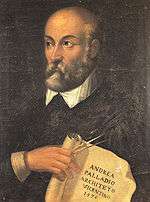Santa Corona, Vicenza
| Church of Santa Corona | |
|---|---|
 | |
| Basic information | |
| Location | Vicenza, Italy |
| Geographic coordinates | Coordinates: 45°32′57″N 11°32′51″E / 45.54917°N 11.54750°E |
| Affiliation | Roman Catholic |
| Province | Vicenza, Veneto |
| Year consecrated | 13th century |
| Architectural description | |
| Architectural type | Church |
| Architectural style | Gothic church, Renaissance chapel. |
| Groundbreaking | 1261 |

Santa Corona is a Gothic-style, Roman Catholic church located in Vicenza, region of Veneto, Italy. The church contains the Valmarana chapel (circa 1576), whose design is attributed to the Renaissance architect Andrea Palladio. Palladio himself is buried in this church.
History
Construction on the church was begun in 1261 by the Blessed (Beato) Bishop Bartolomeo di Breganze to house a thorn from the supposed relic of the crown (corona) of thorns forced on Jesus during his passion. The thorn had been given to this bishop as a gift from Louis IX of France.[1] The church belonged to the Dominican order until suppression during the Napoleonic era.
The church has an altarpiece depicting, the Baptism of Christ (1500-1502) by Giovanni Bellini. The Thiene chapel has frescos by Michelino da Besozzo, and an altarpiece depicting an Enthroned Madonna and child venerated by Saints Peter and Pius V by Gianbattista Pittoni. Other works in the church include an Adoration of the Magi’’ by Veronese, a Madonna of the Star‘ by Marcello Fogolino, a St Mary Magdalen with Saints Jerome, Paola and Monica, (1414-1415) by Bartolomeo Montagna, a canvas depicting St Anthony and friars distributing alms to poor (1518) by Leandro Bassano, and two canvases with depictions of St Sebastian and St Martin by Battista da Vicenza.
Valmarana Chapel
After the death of one of his patrons, Antonio Valmarana, likely in 1576, Palladio designed this funereal chapel. Santa Corona had already been the church were other members of the family had been interred. Ten years earlier, Palladio had designed the Palazzo Valmarana in town for the family. The chapel was constructed by 1597, and family members transferred here. While there is no documentary evidence linking this design to Palladio, it highly resembles his chapels found at the Il Redentore in Venice.
Gallery of the Valmarana Chapel
 Chapel Altar.
Chapel Altar. Dettaglio con lo stemma della famiglia Valmarana
Dettaglio con lo stemma della famiglia Valmarana Detail of Corinthian Capital
Detail of Corinthian Capital One of the two niches in the chapel
One of the two niches in the chapel
References
- ↑ Comune of Vicenza, entry on church.
External links
Sources
- Scheda sul sito dei musei civici di Vicenza
- Valmarana Chapel entry
- Year of Palladio entry for Valmarana Chapel
